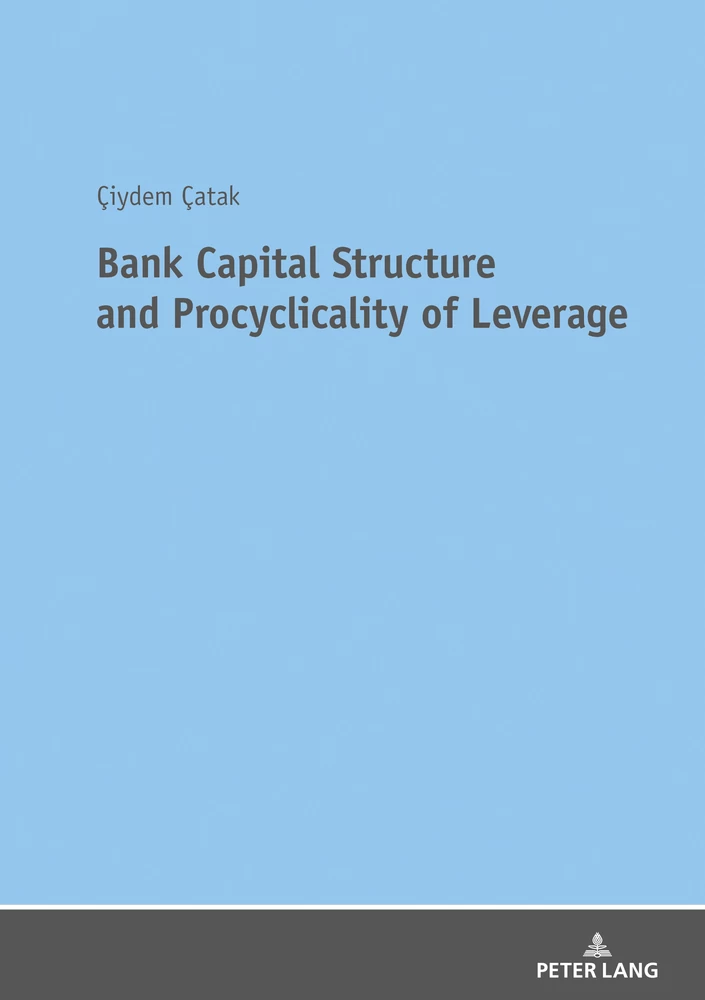Bank Capital Structure and Procyclicality of Leverage
Summary
Excerpt
Table Of Contents
- Cover
- Title
- Copyright
- About the author(s)/editor(s)
- About the book
- This eBook can be cited
- Table of Contents
- List of Tables
- List of Figures
- Abbreviations
- 1 Introduction
- 2 Procyclicality
- 2.1 Definition of procyclicality
- 2.2 Causes of procyclicality
- 2.2.1 Deviations from the efficient market hypothesis
- 2.2.2 Credit rating agencies
- 2.2.3 Economic policy
- 2.2.4 Basel II and procyclicality
- 2.2.5 Fair value accounting
- 2.2.6 Leverage
- 3 The determinants of bank capital structure
- 3.1 Definition of capital structure
- 3.2 Theories of capital structure
- 3.2.1 Modigliani and Miller Irrelevance Theory
- 3.2.2 Trade-Off Theory
- 3.2.3 Pecking Order Theory
- 3.2.4 Agency Theory
- 3.3 Empirical research on the determination of capital structure
- 3.3.1 Determinants of firms capital structure
- 3.3.2 Determinants of banks capital structure
- 4 Research design
- 4.1 Procyclicality of leverage
- 4.1.1 Data and sample selection
- 4.1.2 The variables
- 4.1.2.1 The dependent variables
- 4.1.2.2 The explanatory variable
- 4.1.2.3 The control variables
- 4.1.3 Descriptive statistics
- 4.1.4 Empirical research model
- 4.1.4.1 First model
- 4.1.4.2 Second model
- 4.1.4.3 Third model
- 4.1.4.4 Fourth and fifth models
- 4.1.4.5 Sixth model
- 4.1.4.6 Seventh model
- 4.1.4.7 Eighth model
- 4.1.5 Data analysis and results
- 4.2 Determinants of leverage
- 4.2.1 Data and sample selection
- 4.2.2 The variables
- 4.2.2.1 Size
- 4.2.2.2 Collateral
- 4.2.2.3 Profit
- 4.2.2.4 Inflation
- 4.2.2.5 Gross domestic product
- 4.2.2.6 Money supply
- 4.2.2.7 Exchange rate
- 4.2.2.8 Number of banks
- 4.2.3 Descriptive statistics
- 4.2.4 Empirical research model
- 4.2.5 Data analysis and results
- 5 Conclusion
- 6 References
Table 2.1: Description of Capital
Table 2.2: Risk Weight of Assets
Table 2.3: Features of Each Level in the Fair Value Hierarchy
Table 2.4: A List of Empirical Studies in Literature
Table 4.1: The Number of Banks at the End of the Last Month of the Year
Table 4.2: Variables, Abbreviations and Definitions
Table 4.3: Leverage Ratios
Table 4.4: Descriptive Statistics of Leverage Ratios
Table 4.5: Descriptive Statistics of Explanatory Variables and Control Variables
Table 4.6: Fixed Effect and Random Effect Models
Table 4.7: The Relationship between Leverage Growth and Asset Growth
Table 4.8: The Relationship between Leverage and Asset Growth Considering Banking Groups
Table 4.9: Variable, Abbreviations and Definitions
Table 4.10: Descriptive Statistics of Variables
Table 4.11: Correlation Matrix
Table 4.12: Predicted Effects of Explanatory Variables on Leverage
Table 4.13: The Relationship between Leverage and Bank-Specific and Macroeconomic Variables
Figure 2.1: Proposed changes to elements of the capital ratio under Basel II
Figure 2.2: The procyclicality effects of risk-sensitive regulatory capital
Figure 2.3: Leverage adjustment in upturn and downturn
Figure 3.1: The Static Trade-Off Theory of capital structure
Figure 3.2: Agency costs depending on funding sources
Figure 4.1: Growth of assets and leverage
Details
- Pages
- 120
- Publication Year
- 2018
- ISBN (Softcover)
- 9783631746219
- ISBN (PDF)
- 9783631753033
- ISBN (ePUB)
- 9783631753040
- ISBN (MOBI)
- 9783631753057
- DOI
- 10.3726/b13845
- Language
- English
- Publication date
- 2019 (April)
- Keywords
- Basel 2 Fair Value Accounting Risk-weight of assets Asset growth Debt Equity
- Published
- Berlin, Bern, Bruxelles, New York, Oxford, Warszawa, Wien, 2018, 120 p. 6 b/w ill., 17 b/w tab.
- Product Safety
- Peter Lang Group AG

